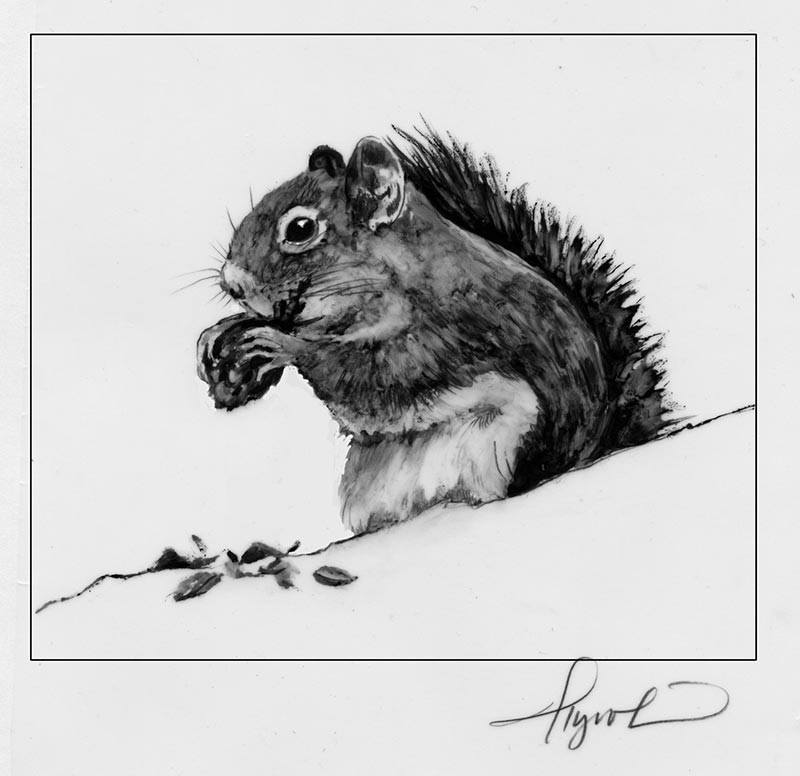
A few summers ago, I saw a red squirrel skittering along the top of a stonewall with something in its mouth. I snuck in closer and discovered the headless body of a chipmunk dangling from its jaws. Prior to that, I’d viewed red squirrels as curmudgeonly little herbivores, not wolves in squirrel’s clothing. It was as if Bugs Bunny had eaten the head off of Alvin the chipmunk.
The cantankerous red squirrels are opportunistic feeders. Their diet consists mostly of vegetarian fare, but in addition to eating nuts, bark, roots, fruit, fungi, buds, and flowers, they’ll partake of everything from insects, eggs, and baby birds to small reptiles, amphibians, mice, baby rabbits, and even cast-off antlers.
During the winter, red squirrels subsist on seeds of cones and may eat up to two-thirds of the pine seed crop produced in a forest each year. Other staples include the seeds of spruce and eastern hemlock, but they’ll also eat those of cedar, larch, and many hardwoods. One study of captive red squirrels found that each squirrel consumed the seeds from an average of 144 white spruce cones each day. Because Norway spruce cones contain numerous high-energy seeds that store especially well, groves of this tree can harbor 4 to5 times the number of red squirrels found in other conifer forests.
I’ve observed red squirrels biting off white pine cones, which land with a “thump” about every ten seconds. When watching a squirrel forage amid Norway spruce, I saw it carry away cones almost as long as its 7-inch body. Most cones are cached in the shade of mature conifers –hoarded for the winter either individually or in mounds called middens that are secreted underground, beneath rocks, or in a hollow tree. A red squirrel’s acute sense of smell can detect seed caches buried under a foot of soil and beneath snow up to 12 feet deep.
One fascinating study of red squirrel behavior conducted by Fritz Gerhardt in a grove of Norway spruce in Norwich, Vermont, found that they habitually raid each other’s middens. On average, each squirrel suffered about a quarter of its seeds stolen by neighbors, while simultaneously stealing about the same proportion of seeds from surrounding middens. However, some squirrels pilfered far more seeds than they had stolen from them, and vice versa, so the actual balance varied between neighboring squirrels.
A red squirrel will frequent the base of a particular pine tree to eat, chewing scales off the core of a cone the way people eat corn-on-the-cob. First, it chews the scales off near the stem. As each scale falls away, a pair of seeds is exposed. Because each subsequent scale lies up the cone and a small turn along the spiral, the squirrel must twirl the cone as it eats. Mounds of discarded scales and naked cone-cores pile up wherever a red squirrel partakes of its pine-on-the-cob.
Terminal conifer buds are another winter staple. Like cones, red squirrels harvest buds using the gnaw-and-drop method. They also munch the buds of maples and birches. In some spruce forests, I’ve seen the ground littered with thousands of branch tips. Although red squirrels look comically mischievous with their black eyes surrounded by white rings, their heavy harvest of seeds and buds, and their penchant for eating the bark of young trees, can seriously damage conifers and their ability to regenerate.
But red squirrels don’t just gnaw the winter away. When not active by day, they hunker down in tree hollows, rocky enclaves, and underground burrows. During extreme cold, these solitary creatures sometimes share shelters. Otherwise they defend territories with vociferous screeches, buzzes, and grating, rhythmic chortlings. In good coniferous forest, red squirrel territories range up to 2 acres.
They breed from about mid-January through mid-February, often during thaws. Dens are in hollow trees, especially old woodpecker nests. Litters of 2 to 5 hairless squirrel-lets arrive about a month after mating. Young grow quickly under the female’s care, start to wander from the nest at around 6 weeks, and are weaned in about 2 months. Goshawks, martens, red-tailed hawks, ermines, red foxes, and other predators eat so many young that only a quarter survive to reproduce the following year.
As winter progresses and sap starts to flow, red squirrels sometimes chew holes in the bark of sugar maples and other hardwoods. After the sap oozes out and evaporation concentrates the sugar, the squirrels return to lap up the sweetness. Europeans who first came to New England learned maple sugaring from indigenous peoples, but we’ll never know how red squirrels figured it out. That closely guarded secret is only handed down on a need to gnaw basis.

